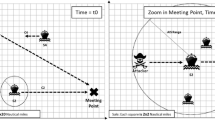Abstract
The Universal Automatic Identification System (AIS) provides a huge variety of potential applications and services which exceed the well known ship-to-ship data exchange. The purpose of this paper is to address the most important AIS services, in particular the AIS position report and the AIS safety-related and binary messages (“AIS telegrams”). The main issue is the impact of this new technology on the on-board use of AIS in collision avoidance (and its limitations) as well as the impact on shore-based services such as Vessel Traffic Service (VTS), port management and the need of an effective AIS network.
Similar content being viewed by others
References
Amendments to the International Convention for the Safety of Life at Sea, 1974, as amended, which were adopted by resolution MSC.99 (73), 2000.
IMO:Recommendation on Performance Standards for a ship-borne Automatic Identification System (AIS). MSC 74(69) Annex 3. London: IMO, 2002.
IALA:IALA Guidelines on the Universal Automatic Identification System (AIS). Saint Germain en Laye: IALA, 2001.
IEC:Class A shipborne equipment of the universal AIS — Operational and performance requirements, methods of test and required test results. Geneva: IEC (IEC-61993-2), 2001.
ITU:Recommendation on the Technical Characteristics for a Ship-borne Automatic Identification System (AIS) Using Time Division Multiple Access in the Maritime Mobile Band. Geneva: ITU (ITU-RM.1371-1), 2001.
Op. Cit. 1
Berking, B., Callsen-Bracker, H.-H.:AIS Binary Messages — Potential Applications and Need for a Centralised Register. In:Ortung und Navigation. 2002, No. 2, pp. 91–99.
Berking, B., Poehlemann, H., Schönemann, K.:AIS Binary Messages — Standardisation of Application-oriented AIS-Messages for Maritime Use. R&D Project FE 40.356/2001. Hamburg: ISSUS, 2001.
Op. Cit. 5.
Op. Cit. 8.
Op. Cit. 7
Berking, B.,Pettersson, B.:How can AIS assist in Collision Avoidance?In: Ortung und Navigation. 2002, No. 1, pp. 15–24.
Op. Cit. 12
Op. Cit. 12
Helsinki Commission:Declaration on the Safety of Navigation and Emergency Capacity in the Baltic Sea Area (HELCOM Copenhagen Declaration). Helsinki: HELCOM, 2001.
IMO:Guidelines for the On Board Operational Use of Shipborne AIS. Resolution A.917(22). London: IMO, 2001.
Op. Cit..
Author information
Authors and Affiliations
Rights and permissions
About this article
Cite this article
Berking, B. Potential and benefits of AIS to Ships and Maritime Administrations. WMU J Marit Affairs 2, 61–78 (2003). https://doi.org/10.1007/BF03195034
Issue Date:
DOI: https://doi.org/10.1007/BF03195034




